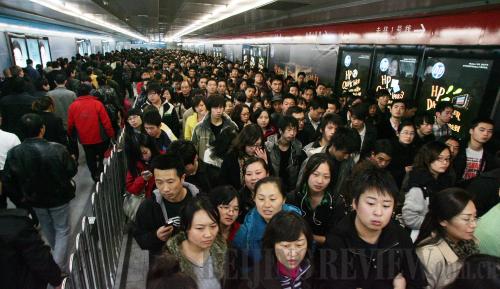|
 |
|
PACKED SUBWAY: Commuters make their way in a passage linking Guomao stations on Subway Line 1 and Line 10 in the morning rush hour (CFP) |
"Every morning when I wake up and think of taking the subway, I feel like I'm preparing to enter a nightmare," said Wang Zili, a secretary with a Beijing-based foreign company who lives in Tiantongyuan, the largest residential community near the North Fifth Ring Road of Beijing in suburban Changping District, home to 230,000 residents.
Wang moved into this community in 2003. "At that time, the traffic was much better. Although there were traffic jams during the rush hour, I could manage to drive to the office on time," Wang said. "Since 2005, it has been getting worse and sometimes I was stranded on the road for an hour during the rush hour."
Wang works near Jianguomen in Chaoyang District, along the downtown East Second Ring Road. The traffic became such a headache for her that she finally rented an apartment closer to her office. "I was afraid I would be late for work every day," Wang said.
She moved back to Tiantongyuan in September 2007 when Subway Line 5, with Tiantongyuan as the northern terminal station, opened.
"I thought the subway would make things much easier. It is free from traffic jams and I can at least control my time. Since it is the first station of the route, I thought I could even get a seat," said Wang.
However, the first day she took the subway Wang was caught completely off guard. "I knew it would be crowded since this community is huge, but I never imagined it would be so awful," Wang said.
People were waiting in zigzag lines outside to enter the station during the morning rush hour. Then, commuters spent more than 10 minutes waiting again in long lines to get on the train.
The situation has remained unchanged.
"As soon as the door opens, the train gets packed in seconds. It is a fight just to take the subway. Sometimes, I have to wait three trains to come before it's my turn to board," Wang said.
Wang's is a normal commuting story in Beijing as the population pressure has become worse in recent years. Compared with Wang, Liu Siqi, who lives around Xierqi Station on Subway Line 13 in Haidian District is much luckier since his employer, Baidu.com, operator the largest Chinese Internet search engine, moved from Zhongguancun, located along the Northwest Fourth Ring Road in the district, to the Shangdi Information Industrial Base, a newly built hi-tech area outside the Fifth Ring Road in the north in November 2009. Liu can now get to his office within 20 minutes by walking.
"Before my office moved here, I had the same terrible experiences taking subways and buses. The situation on buses is even worse," said Liu.
Many of Liu's workmates moved to apartments near the office. The growing demand has boosted the rents and prices of nearby houses.
Now, the average price of apartments near the Shangdi Information Industrial Base is about 30,000 yuan ($4,632) per square meter, while just three years ago, it was 10,000 ($1,544).
"The development of the hi-tech base definitely contributes to the high prices," Liu said.
At the same time, with local operations of multinationals, such as IBM, moving from the downtown East Third Ring Road to the suburban North Fourth Ring Road, the rents of apartments around Pangu Plaza, where the IBM office is located, had once risen by 500 yuan ($77) more per month.
Adjusting plans
"Beijing needs to finetune its urban planning," said Mu Guangzong, a professor at the Institute of Population Research of Peking University. "Otherwise the city will go in the opposite direction of becoming a livable city."
The sixth national population census of China showed the Chinese capital had 19.612 million permanent inhabitants on November 1, 2010, up 44.5 percent or 6.043 million people from 10 years ago.
| 